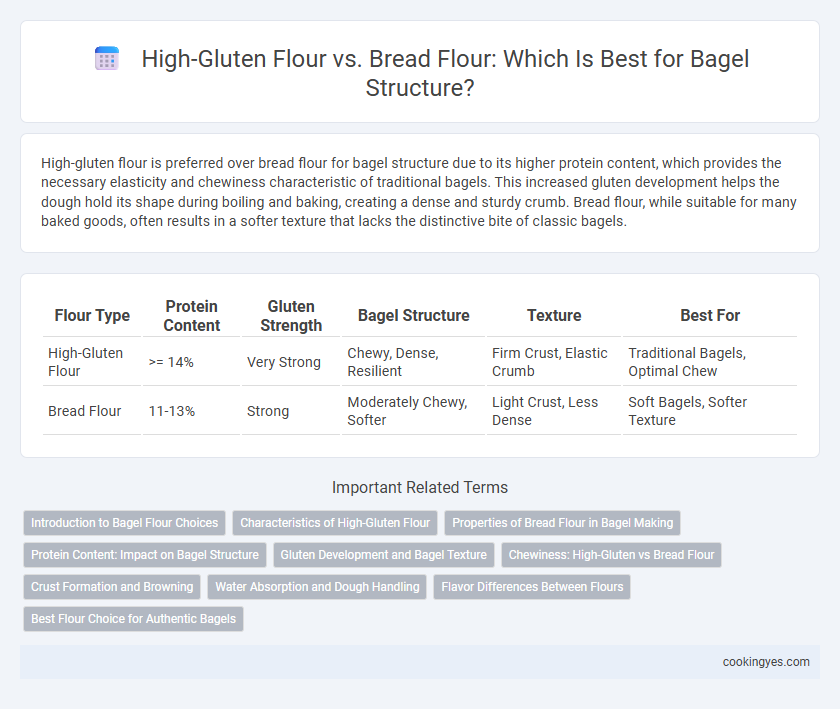High-gluten flour is preferred over bread flour for bagel structure due to its higher protein content, which provides the necessary elasticity and chewiness characteristic of traditional bagels. This increased gluten development helps the dough hold its shape during boiling and baking, creating a dense and sturdy crumb. Bread flour, while suitable for many baked goods, often results in a softer texture that lacks the distinctive bite of classic bagels.
Table of Comparison
| Flour Type | Protein Content | Gluten Strength | Bagel Structure | Texture | Best For |
|---|---|---|---|---|---|
| High-Gluten Flour | >= 14% | Very Strong | Chewy, Dense, Resilient | Firm Crust, Elastic Crumb | Traditional Bagels, Optimal Chew |
| Bread Flour | 11-13% | Strong | Moderately Chewy, Softer | Light Crust, Less Dense | Soft Bagels, Softer Texture |
Introduction to Bagel Flour Choices
High-gluten flour, with its protein content of 12-14%, provides the strong gluten network essential for the dense, chewy texture characteristic of traditional bagels. Bread flour, typically containing 11-13% protein, yields a slightly softer crumb but can still produce a satisfactory bagel structure with proper kneading and fermentation. Selecting the right flour affects water absorption, dough elasticity, and final crust formation, making high-gluten flour the preferred choice for authentic bagel recipes.
Characteristics of High-Gluten Flour
High-gluten flour contains 14-15% protein, providing the elasticity and chewiness essential for bagel structure. Its strong gluten network traps carbon dioxide during fermentation, resulting in denser and chewier bagels compared to those made with bread flour, which typically has 11-13% protein. This increased gluten strength ensures a crisp crust and a characteristic chewy interior, making high-gluten flour the preferred choice for authentic bagels.
Properties of Bread Flour in Bagel Making
Bread flour, with its protein content typically ranging from 11% to 13%, provides a robust gluten network essential for bagel structure, yielding a chewy texture and good elasticity. Its moderate protein level contributes to a balanced dough strength that can trap gas effectively, resulting in bagels with a slightly softer interior compared to high-gluten flour. The moisture absorption properties of bread flour also support a well-hydrated dough, facilitating proper fermentation and shaping without compromising the bagel's characteristic dense crumb.
Protein Content: Impact on Bagel Structure
High-gluten flour, containing 13-14% protein, provides the strong gluten network essential for traditional bagel chewiness and structure. Bread flour typically has a lower protein content around 11-12%, resulting in a softer, less dense crumb that compromises the bagel's characteristic bite. The higher protein level in high-gluten flour enhances dough elasticity and chew, producing the firm yet chewy texture that defines authentic bagels.
Gluten Development and Bagel Texture
High-gluten flour contains 12-14% protein, promoting stronger gluten development essential for the chewy, dense texture characteristic of authentic bagels. Bread flour, with a slightly lower protein content of 11-13%, produces a softer crumb and less elasticity, resulting in bagels that are less firm and chewy. Optimal gluten strength from high-gluten flour enhances the bagel's ability to hold shape during boiling and baking, contributing to its signature chewy crust and dense interior.
Chewiness: High-Gluten vs Bread Flour
High-gluten flour contains 12-14% protein, creating a stronger gluten network that enhances the characteristic chewiness of bagels. Bread flour, with slightly lower protein content around 11-13%, produces a softer, less dense crumb but lacks the resilience needed for traditional bagel texture. Using high-gluten flour is essential for achieving the classic chewy bite and sturdy structure that define authentic bagels.
Crust Formation and Browning
High-gluten flour's elevated protein content, typically around 13-14%, strengthens gluten networks crucial for bagel's characteristic chewy crust and dense structure. Bread flour, with slightly lower protein levels near 11-12%, yields a softer crust and less pronounced browning due to reduced Maillard reaction precursors. Optimal crust formation and deep brown coloration in bagels rely on high-gluten flour's enhanced gluten development and sugar availability during baking.
Water Absorption and Dough Handling
High-gluten flour, containing 13-14% protein, absorbs more water than bread flour's 11-12% protein, resulting in a firmer, chewier bagel texture. The higher water absorption capacity improves dough elasticity, allowing better gas retention during fermentation for a dense crumb. Dough made with high-gluten flour is stiffer yet more manageable for shaping, ensuring the classic bagel structure compared to the softer, more extensible dough from bread flour.
Flavor Differences Between Flours
High-gluten flour produces a denser and chewier bagel with a slightly richer, more complex flavor due to its higher protein content, which aids in gluten development and caramelization during baking. Bread flour offers a softer texture and milder taste, making the bagel less chewy but more tender, with subtle wheat notes. Choosing high-gluten flour enhances traditional bagel characteristics, while bread flour yields a lighter, more delicate flavor profile.
Best Flour Choice for Authentic Bagels
High-gluten flour, with its protein content of 12-14%, provides the ideal structure and chewiness essential for authentic bagels, creating a dense and resilient crumb. Bread flour, containing 10-12% protein, offers good gluten development but often results in a softer texture and less characteristic chew. For achieving the traditional bagel crust and hearty bite, high-gluten flour remains the best flour choice.
High-Gluten Flour vs Bread Flour for Bagel Structure Infographic

 cookingyes.com
cookingyes.com